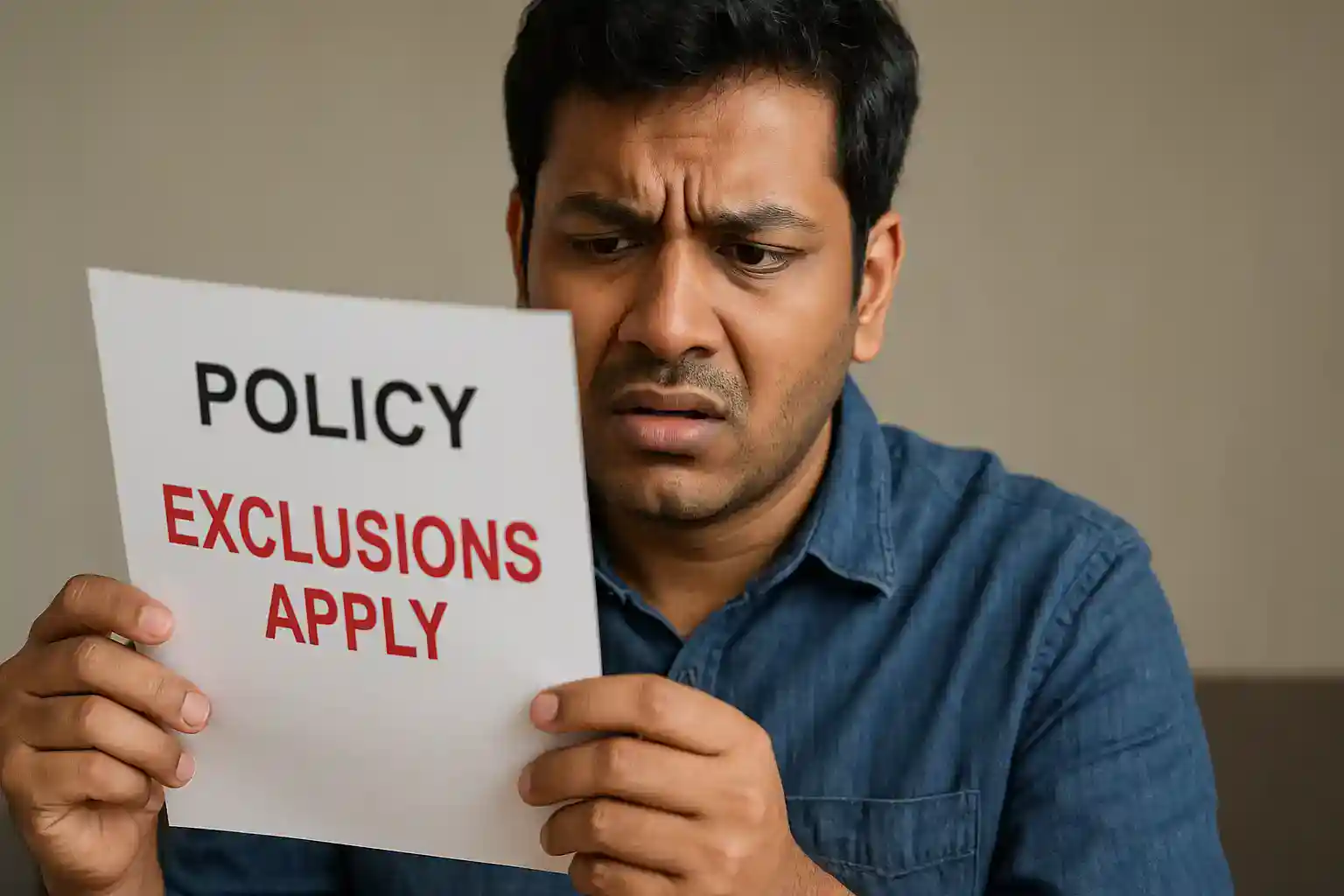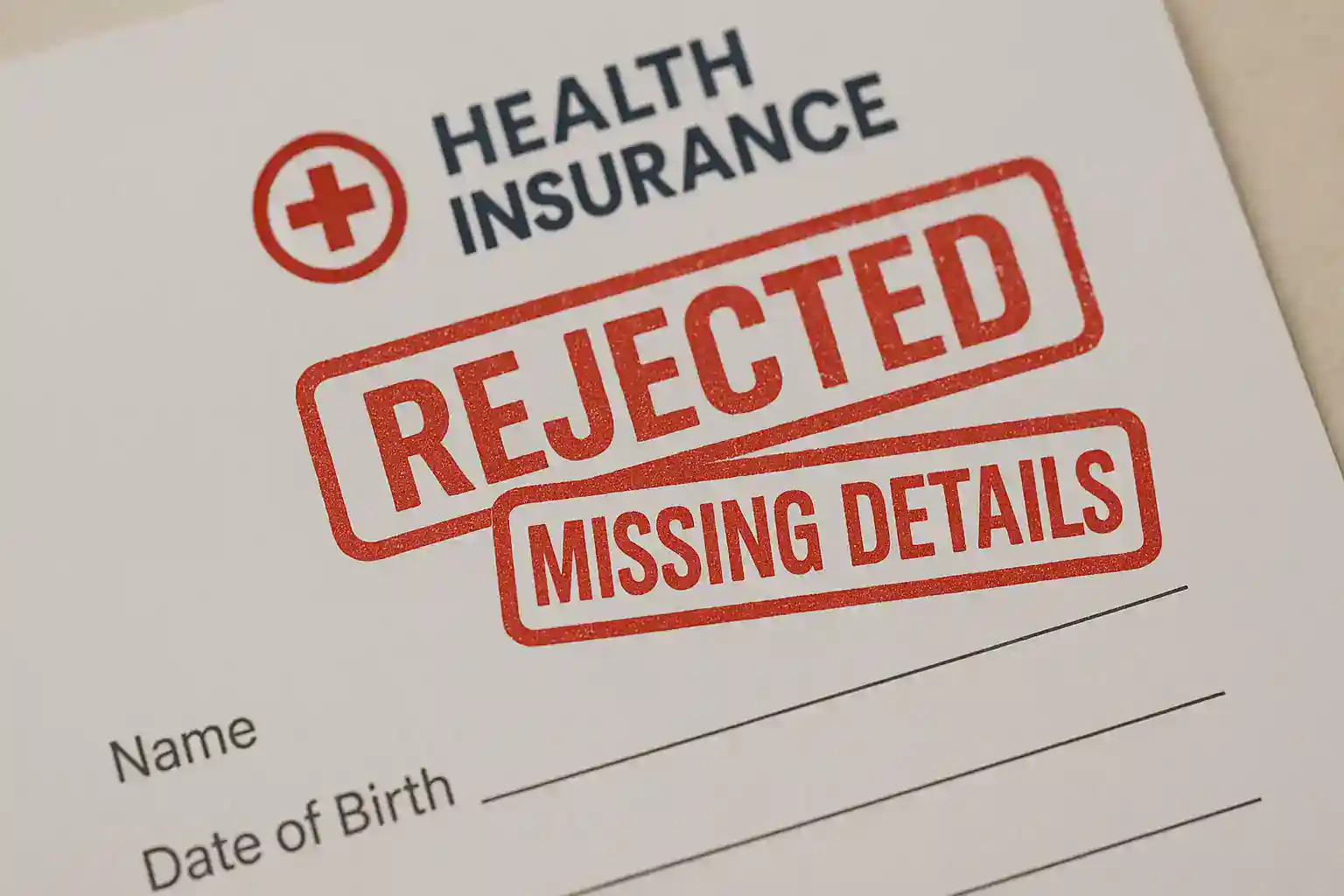Many people lose their claims due to small mistakes made when buying a Policy. 18 Critical Steps: Avoid Health Insurance Traps in India , choose the right plan for your family, and Achieve Financial Freedom.
Why Health Insurance Is a Must in India Today
The increase in medical costs in India is frightening because if a hospital operation costs ₹5 lakh today, it may cost ₹5.7 lakh next year, given 14% medical inflation. Today, 70–80% of Indians are one hospital bill away from poverty. Here is what you need to be aware of to protect your future.
1. Why can you not ignore Health Insurance
- One hospital bill could wipe out your life savings.
- People will use their retirement fund, children’s education fund, or get a loan.
- The healthcare system is the government’s responsibility, but they only offer you tax benefits, indirectly telling you, “Don’t depend on us. Get insurance.
2. The Unkind Reality of Insurance Claims
- Policies are riddled with caveats.
- Sales agents rarely remind you of these facts.
- Claims are routinely dismissed due to caveats, such as coverage not including a certain treatment.
- Admittedly, companies only act responsibly when it goes viral.
3. Knowledge is Power
Do not just buy a policy and think it is job done. You must learn to;
- Select a plan that meets your needs.
- Be aware of every term.
- Be willing to fight for what is your right.
4. Ask Yourself This before Your Purchase
- Can you write a check for a ₹10–15 lakh hospital visit today?
- Even if you are able, how long will it take for you to save that amount again?
- Investments are for long-term goals like retirement or children’s education, and breaking them is disruptive.
5. How Much Coverage Should You Have?
Coverage depends on:
- Location: Rural areas will require less coverage, and Tier 1 cities will require more.
- Health status: Pre-existing conditions require more coverage.
General rule:
- ₹5 lakh per child
- ₹10 lakh per adult
- Top-up or super top-up plans are preferable.
6. Premium Examples for a 28-year-old
With no issues:
- ₹10 lakh cover = ₹600–₹1000/month
- ₹500 for super-top-up of ₹20–30 lakh
Bottom line: It is best to start young to lower the premium.
7. Family Floater vs. Individual Plans?

Family floater plans:
- A family floater policy will cover multiple family members under one plan.
- It is likely to be cheaper than individual plans
Disadvantages:
- Being under a family floater plan means that the sum insured is shared. If one person uses ₹7 lakh from a ₹10 lakh cover, ₹3 lakh remains.
- The family floater premium will be determined by the oldest family member’s age and conditions.
How to Get Boundless Health Insurance Benefits in India:
Solution:
Get separate floaters:
- Parents floater
- Yours and your spouse’s floater.
Bonus benefit: get tax benefit under Section 80D
8. Things to Avoid About Insurance
Trick#1 – Sublimit
- A ₹50 lakh policy could cover a specific surgery for only ₹1-2 lakh.
- Again, if you can, do not have a sub limit
Trick#2 – Room Rent Limit
- A ₹10 lakh policy could allow a limit of ₹10,000/day.
- A plan that has no room rent limit
Trick#3 – Co-Pay Clauses
- A co-payment means you are paying 20-30% of the bill, even with insurance.
- Avoid co-pay policies unless the premiums are not manageable.
9. How to Select the Fit Health Insurance
Use trusted platforms or ask Click Here to Free Advice
Type in your age, current health profile and amount of cover you would like.
Compare policies that:
- Have no sub-limits
- Do not have room rent limits
- Have zero or low co-pay
- Have pre- and post-care hospitalisation days
- Covered general Daycare treatments.
10. Co-Pay, Room Rent, and Sub-Limit Trap

That is why I am paying. So if you are supposed to pay Rs 3 lakh out of Rs 10 lakh, then where is the benefit for such a policy?
Let me explain the reality of co-pay. Still, you think you are contributing only 20%. We will also have to think about whether we have to take a 20% co-pay for room rent, and the sub-limit of the disease will reduce your money to a significant extent.
When all three friends meet, I will clarify with just one example. I have combined all three and have taken the policy document of Star Health. All companies will issue a similar document to you. It is just an example.
Room Rent Limit
Initially, they have specified a ceiling on room rent. They stated as much as 1% of the sum insured. Which is not proper 1%. Look at this:
- When you are taking a sum insured of 15 lakhs, you will get a room rent of 7000.
- That is not even 1% and not even 0.5%. It’s less than that.
Followed by that, the ceiling of your ICU, which is:
- Where there is up to 2% of the sum insured.
- If the sum insured is more than 15 lakhs, then there is an actual charge.
Disease Sub-Limit
Next, we have the disease sub-limit. That is:
- With a sum insured of 15 lakhs, you get 30,000 for your cataract treatment.
- You will get no claim over that.
- So, if a cataract costs 50,000, you pay 20,000. You will get only 30,000.
Now, if you do not know, the good cataract procedure with multi-focal lenses is up to 1.25 lacs in a decent city or hospital. You will never be able to get that treatment with this policy.
Then they grouped many diseases:
- Cerebrovascular accident
- Cardiovascular diseases
- Cancer
- Medical renal diseases
- Treatment of Breakage of Long Bones
The limits are a problem in all these diseases as there is a limit of 4 lakhs on a policy of 15 lakhs. Even in all other major operations, there is a limit of 3 lakh on a policy of 15 lakhs.
For advantages, they have defined properly all other major operations. Otherwise, there would have been a good opportunity for misuse. If you take any disease, they would say that it comes under all. But there is a lot covered under the definition. So, chances are if you take any disease, if that is out of this remaining amount, then you cannot claim for 15 lakh. In addition, the sub-limits are not finished yet.
Claim Illustration-Health Insurance Traps in India
They have provided a claim illustration. So, let us hear about that:
- Let us say the base sum insured is 15 lakhs.
- That is, there is a 15-lakh policy.
- In addition, you have claimed an actual amount of 10 lakh for one hospitalisation.
So, they mentioned a sub-limit for CVA of 4 lakh, which I showed you above. CVA stands for Cerebrovascular Accident. You can write any disease instead of this.
Ultimately, they have only mentioned that you have a disease which is mentioned on which there is a sub-limit of Rs 4 lakh. Now, for CVA, they have not deducted the sub-limit they have only mentioned.
Then, they have mentioned one more thing: the admissible claim amount is 8 lakh. Where did that come from?
It comes from these four points:
1. They will consider a limit for your room rent as much as should be permitted, and not what the actual cost is.
2. Next, they will consider a limit for the ICU as much as should be permitted.
3. Next, they will consider a limit for medical practitioners, i.e., your medical practitioner who is seeing you (only you), 25% sum insured on his fees is permitted. You will not receive more money than that for that either.
4. Also, concerning anaesthesia and OT charges, only 50% of the limit is allowed for you.
Taking into consideration all of these, point A is created, which they have written in bold. This is 8 lakhs.
After this, they will give you a 30% co-pay. Now, you will have to take care of a few things…
- The co-pay of 30% (i.e 3 lakh) is thankfully not applicable to your total claim amount of 10 lakhs.
- The co-pay is 2,40,000.
- Now, on what does this 30% apply? On 8 lakhs.
- What is that 8 lakh? That is the admissible claim amount.
Let’s go ahead and say:
- If we take away 2,40,000 from 8 lakhs, then the admissible claim amount after the co-pay that we have removed is 5,60,000.
- Finally, it is written that the amount finally settled is 4 lakhs.
What was the reason for this?
- Because your sub-limit is Rs 4 lakh.
- Now, whichever is lower rule applies on these two amounts.
- And the 4 lakh is lower.
- So you will get 4 lakh.
Total policy of 15 lakh, claim of 10 lakh, you will get 4 lakh.
11 . Waiting Periods (5 Types Should Check Before Purchase)

- Standard Waiting Period: 30 Days
- If you take the policy today then will you be able to claim for 30 days?
- This is necessary to prevent someone from taking out the policy to avoid prior surgery (planned).
- Confirm if accidents are allowed in this time frame – you cannot plan for an accident.
- Critical Illness Waiting Period: 90 Days
- Ask the executive what the waiting period is for critical illness: 90 days, or something less?
- Also, ask the executive which critical illnesses are included.
- Maternity Waiting Period: 9 to 36 Months
- Varies from policy to policy.
- Ask specifically if you want maternity benefits.
- Pre-existing Conditions Waiting Period: 3 – 4 years
If you already have conditions like heart disease or diabetes, you will have to wait until the 3 – 4 years have expired in most policies to claim.
- Slow-Growing Disease Waiting Period: 2 Years
- Applies even if you contract the disease after taking the policy.
- Examples include: ENT disorders, hernia, cataract, osteoporosis, joint replacement, etc.
12. Restoration of Sum Assured-Health Insurance Traps in India
If you have a policy of 10 lakhs, and use the cover in one year,
- Your cover may be restored for the remaining months.
- Only once per year if you take restoration.
- It may be usable for a different disease only.
- Please, don’t think it is unlimited – it has limitations.
- Ask: In which scenarios would the restoration benefit not be to my advantage?
13. Zonal Policy Trap– Health Insurance Traps in India
Some are pan-India, some are zonal.
What Can Go Wrong?
• You put a rural address – save premium – but get treatment in the city, and that would then impose a 20% co-pay.
• Should have taken a city policy.
What Else Can Go Wrong?
• You take policy for parents in the village, but give a city address – pay an extra premium unnecessarily.
14. Freedom from Zonal Restrictions:
Choose a Health Insurance Policy that provides coverage on a pan-India basis
Whenever you purchase health insurance, be 100% sure whether the policy you are purchasing is zonal or pan-India. The majority of traditional health insurance plans that MHIS covers are on a zonal basis, which means that if you are in the hospital outside of your home zone, you are limited in your treatment options.
What Synth would Do:
- Directly from the insurer, are you zonal or pan-India?
- If you are zonal and your plan is still excellent, ensure your home address is assured.
- If you’re pan-India, not to worry, you are insured across the country, and your policy is much more flexible if you are ever in need during an emergency or travelling.
15. Know Your Policy’s Exclusions from the Beginning
Even with “no room rent limits”, “no sub-limits” and “all diseases included”, there is only one thing that is going to throw a wrench into your plans: exclusions.
Why do Exclusions Matter?
A large number of claims are denied because people do not understand what is excluded from the coverage permanently.
Ask this question before you seal the deal:
Can you provide me with a list of all written permanent exclusions?
Some of the most common exclusions in health insurance policies include the following:
- Pre-existing diseases (during a waiting period)
- Injuries sustained while doing hazardous/adventure sports
- Plastic/cosmetic surgery
- Gender change
- Breach of law/criminal activity
Furthermore, hidden in the fine print are exclusions such as?
Point 1. “Any hospitalisation deemed to be non-medically necessary”.
Insurance companies frequently deny claims under this clause, even with a doctor’s declaration that the admission was required. You may be required to battle your claim through grievance redress, and, if necessary, through the Insurance Ombudsman.
Point 2. “Hospital registration, admission, record, telephone charges“, etc.
These are frequently not payable. If you know this in advance, however, it seldom shocks during claim settlement.
16. Hidden Trap: Policies Geared to Network Hospitals
Some newer age health insurance policies limit claims to only using their empanelled (network) hospitals. That is righ,t not only cashless, but also reimbursement will be denied if the treatment was done in a non-network hospital.
Just think about an accident: no one is checking your insurer’s hospital list – they are rushing you to the ER. If that hospital is not on the insurer’s list, you are on the hook for the whole bill.
This trap is being installed quietly.
You have a Two-Point Checklist before buying:
1. Your policy must allow claims for cashless AND reimbursement.
2. Reimbursement must be allowed even if done in a non-network hospital.
17. The Cashless Claim Myth: Why Reimbursement May Be Better
You might be surprised by this: cashless claims may not always be in your best interest.
Hospitals will usually delay or deny treatment under a cashless policy unless some money is paid in advance. Why? Because payables between the insurance companies and the hospitals are a constant battle.
Solution:
If you have enough savings, simply pay the bills upfront and file a reimbursement later.
- You will get better treatment.
- The hospitals will not shortchange you on treatment.
- If the documents are good, you will have full coverage.
18. How to Select the Right Plan through Policy Bazaar (A Step-by-Step Process)
This is an easy process based on research:
Step 1: Go to Policy Bazaar
Go to PolicyBazaar.com, click on Health Insurance, and fill in the form.
Tip: On the form, be truthful about your health history. Disclose everything honestly. You do not want a situation where you initiate a claim, and it is rejected due to nondisclosure.
Step 2: Set Smart Filters
When you see plans available, do not be distracted by premium or coverage. You need to set the following filters:
| Filter | What to Set |
| Cover Amount | ₹10–24 Lakh |
| Room Rent Type | No Room Rent Limit |
| Pre/Post-Hospitalization | Must be included |
| Daycare Treatment | Must be included |
| No Claim Bonus (NCB) | Select policies that offer NCB |
| Doctor Consultation & Pharmacy | Check if included |
| Free Annual Health Check-up | Preferably included |
| Restoration Benefit | Should be included |
Why No Claim Bonus is Important:
Every year you don’t make a claim, your sum insured grows larger (often by 50%).
E.g., ₹10 Lakh → ₹15 Lakh next year → ₹20 Lakh the next year.
Ask yourself this important question:
“I make a single claim, do I lose my NCB?”
Free Health Check-ups Save You
Many claims are denied based on “pre-existing conditions.”
If you are doing regular check-ups (many insurers pay for them), you can prove that you were healthy beforehand.
Summary of Health Insurance Traps in India
Before purchasing any health insurance policy from India, keep in mind to check:
- No Zonal restrictions if you are aware of them, and accept them
- Full exclusion will have been shared with you
- Reimbursement is possible, also covering unmatched network hospitals
- You have savings, and prefer to reimburse rather than go cashless
- Use Policy Bazaar’s filters wisely to pick plans with the following options:
- No room rents
- Pre/post-hospitalisation
- Daycare treatments
- No Claim Bonus that does not roll back
- Free health checkups
- Doctor consultations & pharmacy
- Restoration of the sum insured
If you want free advice –Click Here
Final Thought-Health Insurance Traps in India
The health insurance sector is changing rapidly in India. A health policy that looks comprehensive may expose you to some pitfalls at critical moments. Consequently, you must do your homework, ask the right questions, and keep an eye on the minor printing while being clever with your packaging.
If you wanted to help support independent awareness content like this, you could have used our [Policy Bazaar referral link] (this is non-sponsored) in the description. There is no compulsion; you can choose any platform that you feel comfortable with.











